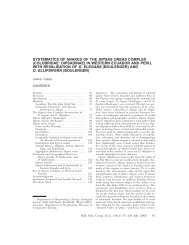cryptic species within the dendrophidion vinitor complex in middle ...
cryptic species within the dendrophidion vinitor complex in middle ...
cryptic species within the dendrophidion vinitor complex in middle ...
Create successful ePaper yourself
Turn your PDF publications into a flip-book with our unique Google optimized e-Paper software.
SPECIES IN THE DENDROPHIDION VINITOR COMPLEX N Cadle 207<br />
group (personal observation). Several o<strong>the</strong>r<br />
works have cited Colombia as part of <strong>the</strong><br />
distribution apparently based on <strong>the</strong>se<br />
sources. Likewise, Lieb (1991) <strong>in</strong>dicated a<br />
locality on <strong>the</strong> tip of <strong>the</strong> Azuero Pen<strong>in</strong>sula<br />
(Cerro Hoya area) on <strong>the</strong> Pacific side of<br />
western Panama, which is far from any<br />
locality from which I have seen specimens<br />
(Fig. 11). Accord<strong>in</strong>g to Jay M. Savage<br />
(personal communication, March 2011), this<br />
locality is based on a misidentified specimen.<br />
Natural History. Dendrophidion apharocybe<br />
is a diurnal snake found <strong>in</strong> humid<br />
forests (lowland to montane ra<strong>in</strong>forests,<br />
cloud forests) and is <strong>the</strong> best known <strong>species</strong><br />
of <strong>the</strong> D. <strong>v<strong>in</strong>itor</strong> <strong>complex</strong> ow<strong>in</strong>g to <strong>in</strong>cidental<br />
or focused attention by students of <strong>the</strong><br />
Costa Rican herpetofauna. Most natural<br />
history data for D. apharocybe come from<br />
<strong>the</strong> relatively well-studied La Selva Biological<br />
Station, <strong>the</strong> type locality, operated by<br />
<strong>the</strong> Organization for Tropical Studies (all<br />
literature references to ‘‘D. <strong>v<strong>in</strong>itor</strong>’’); <strong>the</strong> La<br />
Selva ecosystem is described <strong>in</strong> McDade et<br />
al. (1994) and Holdridge et al. (1971, under<br />
<strong>the</strong> name ‘‘Sarapiquí’’). Guyer (1994: 382)<br />
and Guyer and Donnelly (2005) reported D.<br />
apharocybe as common and semiarboreal,<br />
and Guyer and Donnelly (1990) summarized<br />
data on size, mass, and body proportions<br />
for this population. Guyer and Donnelly<br />
(2005: 185) fur<strong>the</strong>r observed that D.<br />
apharocybe is ‘‘typically observed cross<strong>in</strong>g<br />
trails <strong>in</strong> primary and secondary forest. It is<br />
wary … usually races away when approached<br />
… [and is] an adept climber…<br />
found at night coiled <strong>in</strong> understory shrubs<br />
and trees. At La Selva this snake consumes<br />
…[Craugastor] bransfordii and … [Dendropsophus]<br />
ebraccata.’’<br />
In <strong>the</strong> Cordillera de Guanacaste, Costa<br />
Rica (750–850 m elevation), Stafford (1998)<br />
found two juveniles (about 250 mm total<br />
length) active at 10:00 a.m. and ‘‘late<br />
morn<strong>in</strong>g’’ on sunny June days after ra<strong>in</strong>.<br />
Stafford reported that D. apharocybe is<br />
wary and swift and, when alarmed, raises<br />
<strong>the</strong> head and forebody high off <strong>the</strong> ground<br />
(as shown by photographs <strong>in</strong> Stafford and<br />
Meyer [2000, pl. 113] and Köhler [2003, fig.<br />
479]).<br />
Goldberg (2003) reported reproductive<br />
data for ‘‘Dendrophidion <strong>v<strong>in</strong>itor</strong>’’ <strong>in</strong> Costa<br />
Rica based on a mix of specimens of D.<br />
apharocybe and D. crybelum. Because he<br />
reported data for <strong>in</strong>dividual specimens, it is<br />
possible to extract data for D. apharocybe,<br />
all of which are from <strong>the</strong> type locality. A<br />
gravid female (LACM 148598, 567 mm<br />
SVL) collected 11 December 1974 had a<br />
clutch size of five estimated from yolked<br />
ovarian follicles .12 mm length. A female<br />
(LACM 148609, 657 mm SVL) collected <strong>in</strong><br />
June 1983, although ‘‘not undergo<strong>in</strong>g yolk<br />
deposition’’ (Goldberg, 2003), has swollen<br />
convoluted oviducts (personal observation),<br />
suggest<strong>in</strong>g that it had perhaps recently laid a<br />
clutch. Males undergo<strong>in</strong>g spermiogenesis<br />
were collected <strong>in</strong> April, May, November,<br />
and December (N 5 4); <strong>the</strong> smallest<br />
actively spermiogenic male, collected <strong>in</strong><br />
May, was 420 mm SVL but a smaller<br />
<strong>in</strong>dividual (402 mm SVL) also showed some<br />
evidence of spermatid transformation.<br />
Goldberg (2003) <strong>in</strong>ferred that sperm production<br />
may proceed year-round. Stafford<br />
(2003) <strong>in</strong>cluded specimens of D. apharocybe<br />
<strong>in</strong> an ecological study of Dendrophidion<br />
spp. but presented summary data only,<br />
mak<strong>in</strong>g it impossible to disentangle data<br />
specific to D. apharocybe from <strong>the</strong> o<strong>the</strong>r<br />
two <strong>species</strong> of this <strong>complex</strong>. O<strong>the</strong>r natural<br />
history data for D. apharocybe and D.<br />
crybelum comb<strong>in</strong>ed were summarized by<br />
Savage (2002) and Solórzano (2004).<br />
I made <strong>in</strong>cidental observations of reproductive<br />
condition <strong>in</strong> several o<strong>the</strong>r specimens<br />
(eggs not counted unless previous <strong>in</strong>cisions<br />
<strong>in</strong> a given specimen permitted thorough<br />
study): a female with enlarged (20 mm)<br />
oviductal eggs collected 21 June 1967 (KU<br />
140055, Costa Rica; 612 mm SVL); a female<br />
with three large shelled oviductal eggs<br />
collected 23 February–6 March 1967<br />
(FMNH 170138, Panama; 583 mm SVL); a<br />
female with five large nonoviductal eggs<br />
about 25 mm long collected <strong>in</strong> June 1963<br />
(KU 75680, Panama; 534 mm SVL). The<br />
smallest <strong>in</strong>dividual of D. apharocybe (from<br />
Bullet<strong>in</strong> of <strong>the</strong> Museum of Comparative Zoology harv-160-04-01.3d 11/4/12 19:59:16 207







